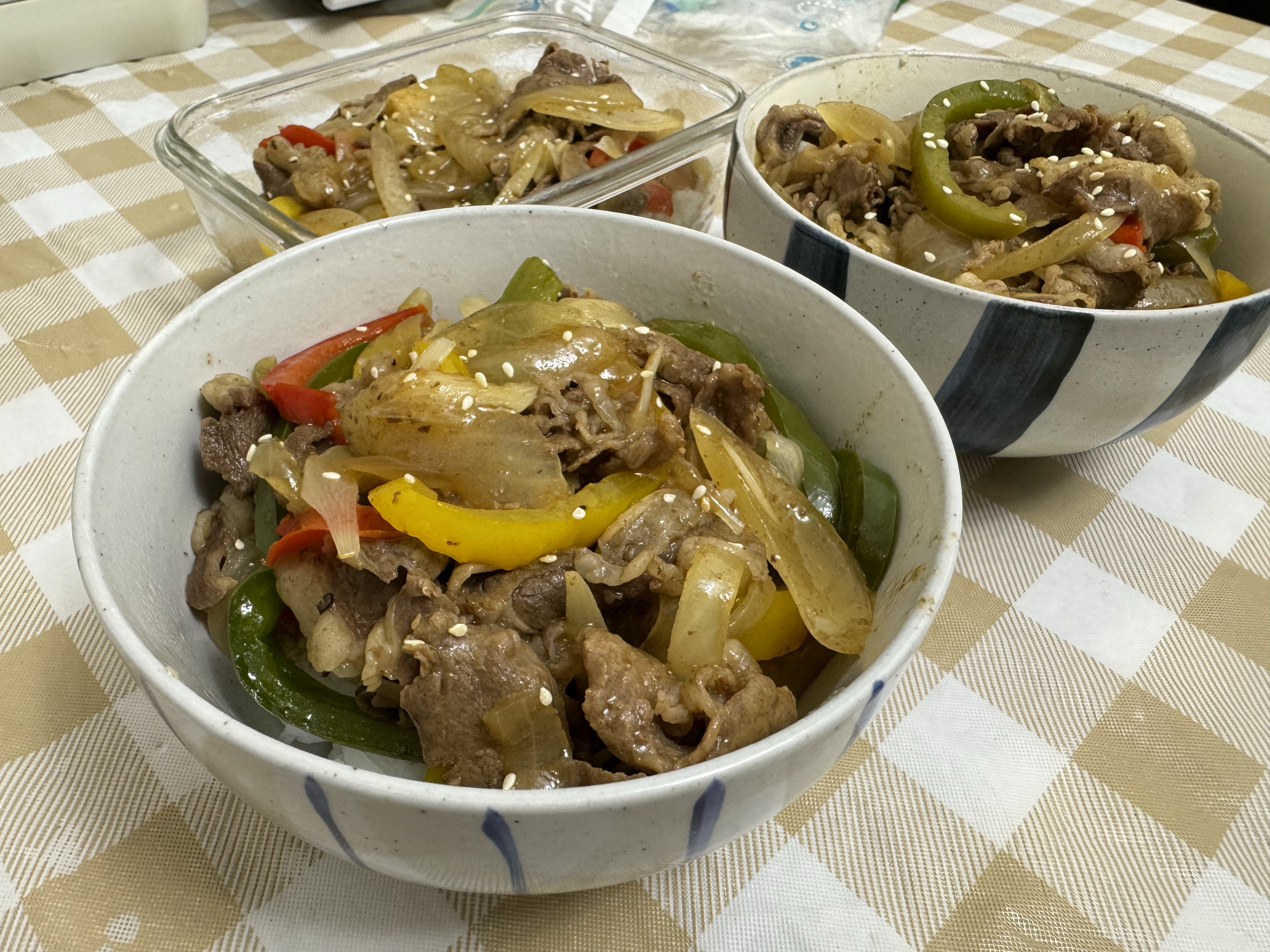Here’s a one-skillet meal that’s loaded with veggies, with enough leftovers to take care of lunch the next day as well. A Chinese take on a Japanese-Chinese classic.

Time: 3/5
Dinner made in the time it takes for the rice cooker to complete its run
Effort: 3/5
After some knife work, it’s smooth sailing
See You Space Cowboy
Rice bowls are a great way to use up leftovers, because it’s such an adaptable format. I had some bell peppers and onions left over from making chicken fajitas, and a bunch of thinly sliced beef short rib left over from a hot pot party we hosted. Normally, it’s a headache to think of ways to stop the leftovers from going to waste. But fortunately, my two problems solved each other.
It began when I thought of whether I could make Gyudon a complete meal without needing another vegetable side dish. I mean, beef plays nice with onions and onions play nice with bell peppers, so what’s stopping peppers and beef from going well together in a stir fry? Pork and peppers is a thing, after all.
Turns out, pepper steak is already a thing. In a case of convergent evolution, I ended up pretty much recreating what the Japanese call chinjao rosu. I should know better, seeing as how it made an appearance on Cowboy Bebop. Great anime, by the way.
I would call my experiment a success. Bulking the beef out with peppers and onions was the right call, and the stir fry sauce was on point. It’s not very scalable, but that’s what happens when you’re limited by the surface area of a skillet. But for feeding 3 to 4 people, it’s hard to beat the ease and convenience of a rice bowl like this.

Dramatis Personae
Served 3.
Beef – 1lb, sliced very thin.
The beef marked for shabu-shabu or hotpot (something like this) is perfect for this. The manufacturer (or retailer) makes razor thin slices from a block of frozen beef that cook quickly and conveniently. You could slice your beef by hand, but at that point I wouldn’t find the effort-to-reward ratio worthwhile.
Keep it frozen, that way it’s much easier to separate the pieces without them shredding up into nothing. They defrost and cook super quickly once they come in contact with the sauce.
Vegetables – 3/4 of an onion, and 3/4 each of all 3 colours of bell pepper.
Already cut and cooked in my case, but it isn’t too much work to prepare specifically for this recipe. Err on the side of caution when considering quantities, onions and peppers always surprise me with how much volume they occupy once they’re prepped and cut up.
Garlic – 2 cloves, sliced thin
It feels wrong to have a stir fry without garlic, so here it is. Usually I add it right at the beginning to perfuse the cooking oil with toasty flavours, but sometimes I like to leave them towards the end to get a more pungent, fresh aroma.
Sauce
Based on my trusty all-purpose stir fry sauce: roughly a tablespoon each of light soy sauce, oyster sauce and Shaoxing wine. The exact proportions don’t matter, it will taste good even if you’re missing one of the trio.
Optionally, add a drizzle of sesame oil towards the end of cooking, and/or a bit of corn starch slurry to thicken the sauce.

Executive summary
- Make rice. Clean and cut vegetables and aromatics.
- Stir fry vegetables in a bit of oil on medium heat until slightly wilted.
- Add sauce ingredients, then the beef. Stir occasionally.
- When beef is almost done, add sesame oil and/or corn starch slurry if desired.
- Assemble and serve.
Play by Play


Showing this for completeness’ sake. Yesterday, I stir fried some onions and bell peppers with a bit of salt. They were for some chicken fajitas, but I ended up with much more fajita vegetables than I needed.

Separate out and toss the pieces of beef in while they’re still frozen. Stop looking at me like I’ve gone crazy, try it and see for yourself how much easier it is to do it this way than to defrost the beef and deal with the droopy greasy mess. They’ll defrost in the pan in no time.



I added my vegetables back into the pan when the beef was about half done. The sauce went in at the same time, and by the time the beef was cooked through everything has been stirred and combined.

Hmm. The sauce is looking a bit thin, even though the grease that has rendered from the beef seems promising for a tasty meal. Let’s thicken the sauce up with a slurry.


About a teaspoon each of corn starch and water, mixed together with my index finger and poured into the skillet. Stirred immediately to disperse before it has a chance to clump. I forgot to take an after pic, so you’ll have to take my word for it when I say it thickened up the sauce so it clung onto the food better.

Nothing fancy, but most weeknight meals don’t have to be.
Thanks for subscribing! See you around.
Keep browsing by categories, or by tags:
Beef Blog Broccoli Cabbage Carrots Cast iron Cheese Chicken Curry Dashi Date Night Dried scallops Dried shrimp Eggs Fish and seafood Garlic Ginger Glass noodles Gochujang Honey Miso Napa cabbage Onion Oven Pasta Pork Potatoes Salmon Sesame oil Shiitake mushrooms Shrimp Soup Sous Vide Steaming Stewing Stir fry String beans Sweet potatoes Teriyaki Tofu Tomatoes Vacuum cooker Vegetarian Yogurt Zucchini
